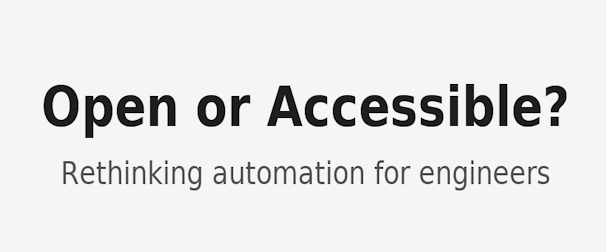
There are trends in automation, same as in any sector of industry and one of the current trends is for “Openness”.
The support for most systems is supplied by the original vendor; it is difficult for others to get involved with the coding, (and this may be more the case as security and protection become more relevant in automation). For example, if a new vessel is being added to an existing Tank Farm then the site owners can organise the purchase and installation of the vessel and the wiring of control devices and instruments, but feel constrained in integrating the new vessel in the existing software. They feel they have to use the original SI or OEM company that supplied the Automation or the original tanks. It may be fine to use the original organisation but sometimes site owners would like to have a choice to use another. Even if they have the PLC and Scada code it may be difficult to get other SI companies to tackle the integration due to the learning process and the possibility of being responsible for any issues that have been masked since the original installation. It is possible that the takeover of the software can be a significant part of the expansion, even though when it is finished it will be another tank and selection on the Scada.
The idea of Openness is to address this by putting the control of the standards and the software back to the owners of the plant. A major initiative in this line is the Open Process Automation Forum (OPAF) group, which is focused on developing a standards-based, open, secure, interoperable process control architecture; basically to lessen vendor lock-in and increase client ownership. It was suggested by ExxonMobil and is supervised by the Open Group, and is a consensus-based group of end users, suppliers, system integrators, standards organizations, and academia which addresses both technical and business issues for process automation. It has produced a document for standards and white papers. The direction of the forum seems to be for systems composed of many small local controllers, in turn controlled by a larger Scada/MES. It may be similar to Module Type Package concept. Another major manufacturing company, Intel, have made their Policy Engine technology, to interact with Automation vendors, to have more say in the design and implementation of their systems.
We have preferred to go with user-friendly and Accessible concepts. Accord Designer presents systems in a configuration, without code, and is accessible to all types of engineers and avoids the confusion that can come from PLC programming ‘styles’. Using the Accord framework allows a client company to avoid the commercial difficulties which can arise from having closed vendor-only coding.
OPAF type initiatives are great but seem to introduce a lot of additional complexity, in an already very complex arena. We genuinely believe that the easy approach is better for software; that configuration, instead of coding/scripting, using Accord Designer provides a good alternative to Openness or other complex methods as Accord keeps system integration easy to design and manage.
While “Openness” / OPAF explores a future of distributed compute nodes replacing I/O networks, Accord lets engineers design and implement control systems without writing code. Accord takes today’s PLCs and makes them no-code, object-oriented, and model-driven.